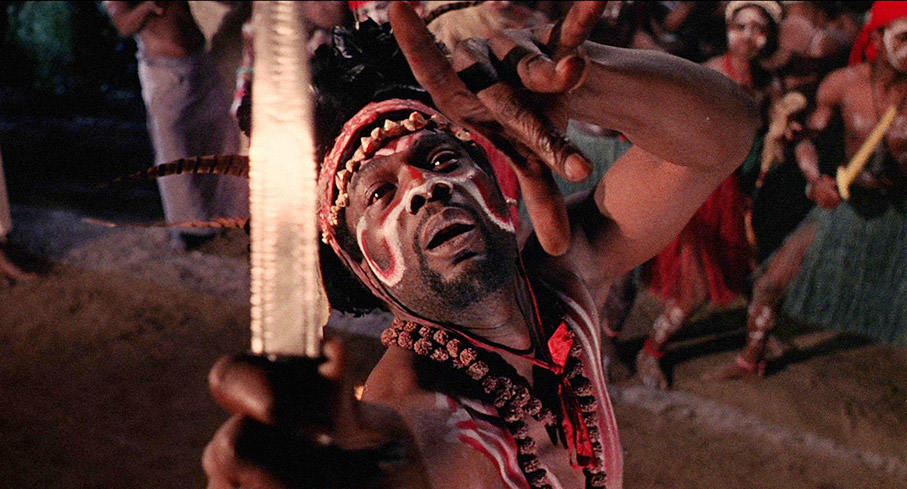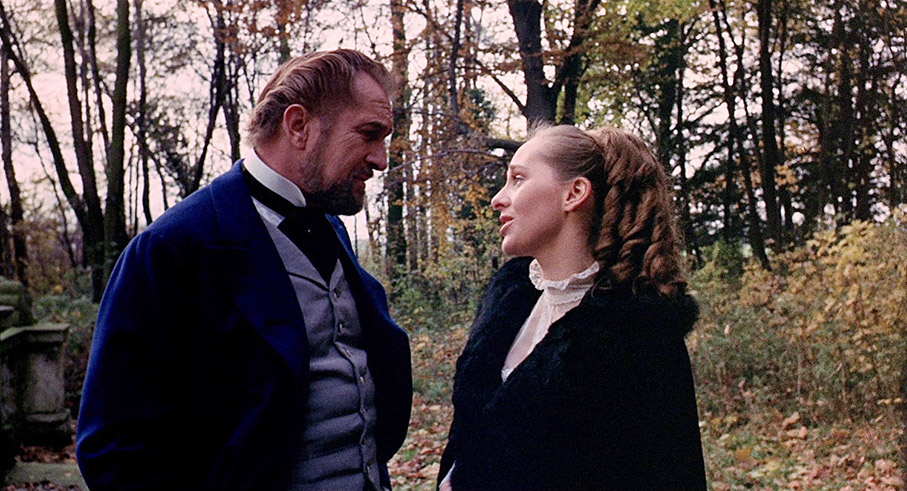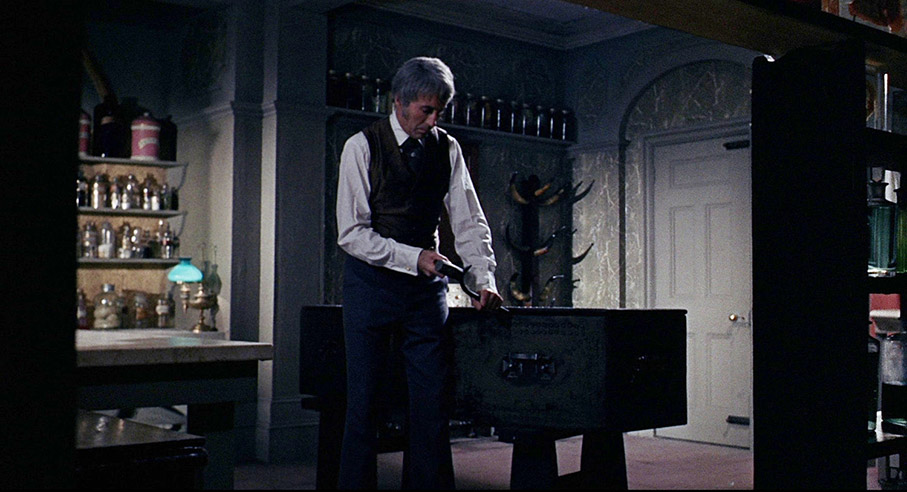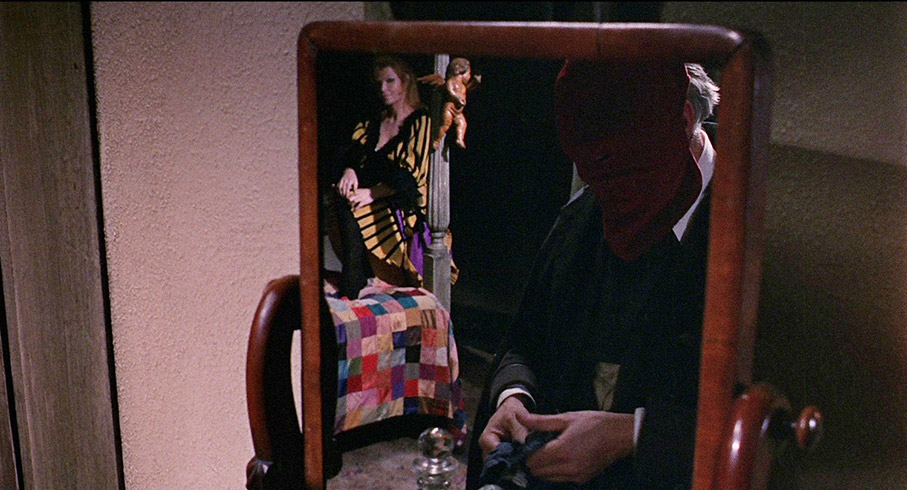|
1865. In Africa, Edward Markham (Alister Williamson) is disfigured in a native ceremony, witnessed by his brother Julian (Vincent Price). Back in England, Julian, looking to marry Elizabeth (Hilary Dwyer), keeps Edward captive, faking his death with the help of family lawyer Trench (Peter Arne) and African witchdoctor N'Galo (Harry Baird). Julian hires body snatchers to find a corpse to take the place of Edward as he lies in state, and he later buries the real Edward, still in his deathlike trance. However, Edward's body is exhumed and given to surgeon Neuhartt (Christopher Lee) for his experiments, only for Edward to revive when the coffin is opened, out for vengeance...
The Oblong Box (1969) has a proprietary credit on screen, Edgar Allan Poe's The Oblong Box, and that's significant as this was the last of adaptations from that author made during the 1960s for American International Pictures (AIP), though some of them, this included, were actually shot in the UK. Some of the films have more to do with Poe's originals than others, in a few cases nothing at all except for the title and some thematic elements. They also show the development of the horror genre in that decade, sometimes pushing at the limits of what was allowed by the loosening censorship of the time, particularly in the depiction of violence. That was certainly the case with Witchfinder General (1968), directed by twenty-four-year-old Michael Reeves. AIP released the film in the US, retitling it The Conqueror Worm and justifying using the title of Poe's poem by having the film's star Vincent Price read from it in voiceover at the beginning and end.

The Oblong Box began as an original screenplay by writer and director Laurence Huntingdon, first called The Man in the Crimson Mask. At first AIP considered asking Huntingdon to direct (as he had previously made some thirty films, mostly low-budget B movies with none of them by all accounts particularly distinguished) but decided to offer the job to Reeves. The script is credited to Huntingdon with Christopher Wicking providing "additional dialogue", but in fact Wicking, with some input from Reeves, rewrote it extensively. The African pre-credits sequence was new to this version, with even at this stage Reeves indicating the use of subjective camera from Edward's point of view. Reeves cast some of the supporting roles (Vincent Price had been imposed on him, as he had been in Witchfinder General, on which they had clashed, though Reeves got Price to tone down his usual theatricality, resulting in was one of his finest performances) and scouted locations in Ireland. However, an overdose of alcohol and barbiturates (which Reeves survived) caused AIP to reconsider their employment of Reeves, and they replaced him with Gordon Hessler. German-born Hessler had directed one previous feature (Catacombs aka The Woman Who Wouldn't Die, 1965). He had some input into the script, but scrapped Reeves's plans for shooting in Ireland, instead using locations close to the studio base in Shepperton. The film was shot in November and December 1968. By the time it had completed, Laurence Huntingdon had died, on 29 November at the age of sixty-eight. And on 11 February 1969, Michael Reeves also died, aged just twenty-five, from an overdose of alcohol and barbiturates, whether accident or suicide will likely never be known.
While Reeves did not end up making the film, the film still bears his marks. One is the portrayal of violence, though as with the earlier film, the onscreen blood does look like red paint. However, its presence – taking not many prisoners with an early shot of a nail being driven into Edward's palm – is an indicator of how far this material had become more acceptable in mainstream cinema, not just in the horror genre, but elsewhere in the likes of Bonnie and Clyde and, the same year, The Wild Bunch, which took onscreen bloodshed to new levels for adult audiences. Also pushing the envelope a little is some sexual content, including brief nudity (female, breast exposure). The Oblong Box did have issues with the censors on both sides of the Atlantic (see below for further details). It was banned outright in Texas, though one can speculate that that might have had something to do with an educated black man in the film. N'Galo's dialogue had been rewritten by Wicking to be more articulate than the broken English he spoke in Huntingdon's original script.
There is an overlap in personnel between The Oblong Box and Witchfinder General. Both films were shot by Dutch cinematographer John Coquillon. In both film's casts, there is Vincent Price but also Hilary Dwyer in a rather thankless role as Julian's fiancée. (Dwyer went on to become a film producer under her married name Hilary Heath.) Christopher Lee has a "special guest star" credit, and it's true that the film for most of its length keeps his and Price's storylines separate, and they have just one scene together. You could argue that the real protagonist is Edward, but Australian-born Alister Williamson doesn't show his face until the end, and then only in a few shots in near-darkness. His voice was also dubbed by an unknown actor (rumoured to have been Robert Rietti).

While it's as much shoehorned into AIP's Poe cycle as Witchfinder General was, it does make an effective closer to it. Its patchwork beginnings don't show, and Hessler's direction is fluent and well-paced. Hessler went on to collaborate with Christopher Wicking four more times: Scream and Scream Again (1970), Cry of the Banshee (also 1970), Murders in the Rue Morgue (1971) and Medusa (1973). Wicking died in 2008, aged sixty-five, and Hessler in 2014, eighty-eight.
The Oblong Box is released on Blu-ray by the BFI, on a disc encoded for Region B only. The film now has a 15 certificate, but its censorship history is complex. The Oblong Box was cut for an X certificate (then, restricted to those aged sixteen and over) in 1969, but the distributors then shortened the film and made some of the same cuts to achieve an American M rating. The M stood for "mature" but despite that was a parental-guidance rating, from when the Motion Picture Association of America (MPAA) instituted its ratings system in 1968 until 1970. Then it was replaced by the GP (general patronage) and then in 1972 the letters were reversed to become the PG which exists to this day. It was the M-rated version (87 minutes 34 seconds with PAL speed-up, so about 92 minutes at cinema speed) which was passed 15 for homeviewing in 1987 and 1993. From 2008, the version available has been the full uncut version, and that's what's on the present Blu-ray. The Pit was an X in 1963 and is now a 12, cut neither time. The Bells and Prelude don't appear on the BBFC website as I write this, but neither would be higher than PG.
The film was shot in 35mm colour, and the Blu-ray transfer, from a HD master supplied by MGM, is in the intended aspect ratio of 1.85:1. Some of the day-for-night exteriors are quite dark and murky, but that's no doubt down to the original film. Coquillon's cinematography is richly coloured, and blacks are solid with natural and filmlike grain.
The soundtrack is the original mono, rendered as LPCM 2.0. Not much to say here, as it's a professional job of work, with dialogue, music and sound effects well balanced. There are optional English hard-of-hearing subtitles, for the main feature only. I didn't spot any errors in them.
Commentary by Steve Haberman
Recorded in 2015, critic and film historian Steve Haberman gives a very detailed commentary, going into quite some detail about the film's troubled production and the differences between the original draft and the final version. Haberman does fill us in on the filmographies of many of the cast and crew, but does rather more than simply read an IMDB or Wikipedia entry: there is information about the death of at least one person that you won't find at either place, at least not at the time I write this. There are some dead spots, but it's a well-informed talk well worth listening to.

The Immortal Mr Price (16:53)
An interview with Victoria Price, Vincent's daughter by his second (of three) wives, Mary Grant. She states that she was something of a surprise, her mother discovering she was pregnant at age forty-four, not having had a child before. (Price had had a son by his first wife.) In 1999, six years after her father's death, she published a biography of him. As well as the biographical details, augmented by family photographs, she talks at length of how cultured her father was, to the point where he frequently had to defend himself, a Yale-educated man, against acting in horror films many felt beneath him. He become friends with Christopher Lee, an equally if differently cultured man with whom he coincidentally shared his birthday. It's particularly clear that Price admired Edgar Allan Poe, which informed his acting in as many Poe adaptations he did. We also hear about his extensive art collection and in particular his appreciation of African art, which plays a part in The Oblong Box. There's nothing about Price's fame as a gourmet, but no doubt that part of the interview is being held over to the BFI Flipside release of Cooking Price-Wise, due as I write this in November 2024.
The Bells (14:35)
Made for the Edison company in 1913, directed by George Lessey, The Bells is based on Poe's narrative poem, published posthumously in 1849. Lucy (May Abbey) loves Donald (Augustus Phillips) but is pressured by her father (Robert Brower) to marry Leo (Frank McGlynn Sr). However, fate lends a hand in a melodramatic short. Presented in its original aspect ratio of 1.33:1, this was shot at sixteen frames per second, with every second frame duplicated so that it can play on this Blu-ray at 24fps.
Prelude (6:53)
From 1927, this silent film depends on its music, specifically Rachmaninov's Prelude in C Sharp Minor. Written and directed by Castleton Knight, this short borrows heavily from Poe's The Premature Burial as a man's reading of the story causes him to hallucinate about being buried alive. Presented in 1.33:1 with the original black and white tinted yellow or blue, the transfer has no duplicated frames, indicating that it was shot at the sound speed of 24 fps. That was forward-thinking of Mr Knight and his crew, but then 1927 was the year of The Jazz Singer.
The Pit (26:54)
This short film (which has been on Blu-ray before, as an extra on the BFI's release of Schalcken the Painter) was written and directed by Edward Abraham, from the short story by Edgar Allan Poe. It was financed by the BFI Experimental Film Fund in 1962, for a total budget of £876. That's about £19,250 in 2024 sterling if Google tells me right and clearly a pitiful amount of money. The cast and crew donated their services but even so, this is a remarkable film on such a tiny budget, which stretched as far to allow it to be made in 35mm black and white. There is just one line of spoken dialogue ("Morte!") so the film relies on the direction, Gus Coma's lighting (heavy on the chiaroscuro), an atonal score by Leslie Harverson and the performance of the lead and only credited actor, Brian Peck. The transfer, in the original ratio of 1.33:1, comes from a restored 35mm print, and is very fine, some minor scratches and spots notwithstanding, and shows how monochrome 35mm really lends itself to HD, with those shadows inky black.

Roger Corman on Edgar Allan Poe (9:48)
Corman talks to camera about Poe, whom he read avidly as a child. By the end of the 1950s, Corman had established himself as a maker of horror/science fiction films, shot quickly, in black and white, often released as a double bill, but the market for this was declining. He pitched The Fall of the House of Usher(1960) to AIP as a larger production on a longer schedule (still only fifteen days) to be made in colour and Scope. The resulting film was successful and Corman went on to make seven more Poe adaptations, all but one of which starred Vincent Price, and we see extracts from them. The Tomb of Ligeia (1964) was the last. Corman considered it the best, but he wished to move on to more contemporary subjects, particularly those involving the emerging 1960s counterculture. Corman's legendary parsimony was still in evidence: he took advantage of sets created for Becket (1964) to make The Masque of the Red Death (also 1964) look more lavish than it might otherwise have done. He also pays tribute to some of his collaborators, such as screenwriters Richard Matheson and Robert Towne and Red Death cinematographer Nicolas Roeg.
Theatrical trailer (1:54)
Beginning rather tautologically with "The Living Dead Live!", this trailer packs a lot in to just under two minutes, with a recurring purple logo in the shape of the box of the title. The film title finally appears inside it.
Image gallery (6:00)
A self-navigating gallery comprising stills (black and white), front of house cards (colour), a press kit and admats, and poster designs from both the USA and Italy, the latter retitling the film rather more bluntly as La rosa maschera del terrore (The Red Mask of Terror).
Booklet
The BFI's booklet, available with the first pressing of this release only, runs to twenty-four pages. It begins, after a spoiler warning, with "Unlocking the Oblong Box" by Peter Fuller. This covers the film's genesis, as a follow-on to the Corman-helmed Poe adaptations for AIP and Witchfinder General, and production, with Price's fee and expenses enabling him to scour London's galleries and markets to invest in artworks. Fuller also discusses Price's friendship with Lee, with the latter taking his smallish role so that he could work with the former. Their friendship continued after a fashion following Price's death in 1993 as every Christmas Lee would wear a hat that Price had given him as a gift. Fuller then goes on to cover the supporting cast and the film's reception, which was critically mixed but commercially solid.

"Boxed-In and Bowing-Out: Michael Reeves Quits The Oblong Box" by Benjamin Halligan as the title suggests puts an emphasis on Michael Reeves and what proved to be the end of his career and life. This gives a good picture of Reeves's position at the time, suffering from mental exhaustion and ambivalent about taking on this particular film, part of a genre then in decline and with worries about what the BBFC would do to the finished film. Halligan discusses other projects Reeves was working on at the time, which would all never be made. They sound intriguing, including All the Little Animals, which would have been proto-folk horror as Witchfinder General was, and a 16mm-shot biker movie starring Peter Fonda which might have predated Easy Rider. However, his medication for depression and more than one non-fatal overdose made insurers uneasy and he was replaced by Gordon Hessler. He never made another film.
After a cast and crew credits listing for The Oblong Box, there are notes on and credits for the extras, with Steve Haberman's commentary missing for some reason, at least on the PDF copy supplied for review. There is an extended note by James Bell for The Pit, which begins with an overview of cinematic Poe and continues with a discussion of the short film itself. Unlike other alumni of the BFI Experimental Film Fund, such as Ken Russell and Tony Scott, Edward Abraham didn't go on to a further career, apart from one TV play as director and two scripting credits. Also in the booklet are plenty of stills.
The Oblong Box is a film of its time, marking the end of AIP's cycle of Poe adaptations and reflecting ways in which the horror genre was changing at the end of the 1960s. Fans of Vincent Price, Edgar Allan Poe and to a lesser extent Christopher Lee would be the market for this Blu-ray release from the BFI.
|